Juggling - its history and greatest performers by Francisco Alvarez
PART 1: Early History
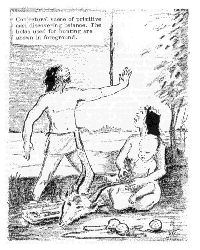 |
| Conjectural scene of primitive man discovering balance. The bolas for hunting are shown in foreground. |
Unlike the well-defined and comparatively recent beginnings
of technological inventions, the origin of juggling is very ancient.
Juggling is closely associated with pantomime, dance, and music.
When primitive man engaged in religious rituals, he began to
exhibit such abilities as the singing of crude chants,
hand-clapping, and the striking of sticks together. Other reasons than
religious enthusiasm often prompted these ceremonies. They also
served to release surplus animal spirits, and to observe such
events as births, hunting, war, and death. The belief that some
form of juggling has always existed is obviously sound, as we can
see from these early stick twirlers. Not much is known about the
centuries that followed. We do know that elaborate processions
were common in ancient Mesopotamia. Huge companies of
entertainers are known to have taken part in these processions.
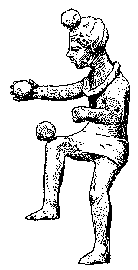 |
| Roman juggler, after a clay figure in the Staatliche Museum in Berlin. |
The first graphic representations of jugglers appear on wall
paintings of the Egyptians and on Greek vases of a very early
period. Although much has been said about this, one of the most
informative accounts appears in the 1938 February and March
issues of Linking Ring magazine. In this magic publication, the
article by Dr. Henry R. Evans, "Jugglers and Juggling," gives us
specific names and locations: "We see representations of it
(jugglery) in wall paintings of the Egyptians, particularly in
those of Beni-Hassan tombs on the east bank of the Nile near
Speos Artemidos." Dr. Evans further informs us that, "an
inscription to Septimus Spika, evidently a popular juggler of
ancient Italy, appears in the Royal museum at Mantua," and that,
"he is represented keeping seven balls in movement." A statue in
the National Museum in Athens, Greece, which was found in the
Pyrénées, also attests to the antiquity of juggling. In Greek
history we learn that itinerant minstrels, or bards, had traveled
through Sparta, possibly to take part in the popular contests in
music and diversions displayed there in 675 B.C. To increase the
pleasures of Rome, it was fashionable to import entertainers from
the Orient. No doubt there were jugglers among them, though
they were almost always slaves or not socially accepted. Hermann
Sagemüller writes of an officer in a Roman Legion who entertained
his troops by performing juggling tricks with balls. The name of
the officer is given as Sidonius Apollinaris. [1]
THE ORIENTALS
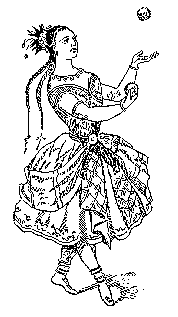 |
| Nineteenth century woman from India, after a print in the Ziethen collection. |
China has more than 3,000 years of recorded history and the
ancient Chinese were, even during their early history, skillful
craftsmen. The manufacture of temple gongs, furniture, and small
ivory-tipped articles were highly developed industries. Some of
these artifacts go back to Shang (or Yin) dynasty (1766-1112
B.C.). An early musical instrument known as the pipa (similar to
our mandolin) originated in China. And one of the oldest props in
juggling also had its beginning in that country. Known as le
diable in France, in English-speaking countries it is known as the
devil on two sticks or diabolo.
This prop consists of a spool resembling two cones fastened so
that the narrowest point is in the center. The spool is manipulated
by means of a string attached to two sticks which are held in the
hands. The devil sticks are closely related to the diabolo, though
the historical connection is not clear. The devil sticks make no
use of the string; two sticks, one held in each hand, manipulate a
third stick by knocking it back and forth and making it spin in
various ways.
Much of the culture of China entered Japan by way of Korea in
the seventh century. But both countries retained their juggling
identity. The spinning of plates on slender rods, and some
contortionism combined with this, has been popular with the
Chinese for centuries. The Japanese, on the other hand,
preferred to toss little sticks and balance, roll, and bounce a
medium-sized ball on various parts of the body. Before the
vulcanization of rubber, these balls were made by winding a
length of yarn. Jugglers of the Orient had one thing in
common - their props were often shaped so as to depict birds,
fish, and other animals. Thus it was not unusual to see a wooden
fish balancing on a juggler's chin. Additional movement and
flexibility was achieved by joining different parts of the animals
with hinge-like devices, creating the illusion of flapping wings
and wiggling tails. As late as 1934 I saw a Japanese juggler using
such props.
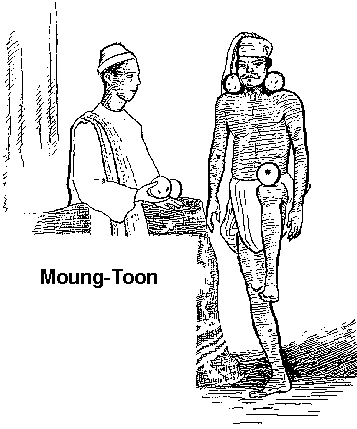 |
|
Moung Toon, The Marvellous Burmese Juggler. The amazing part of Moung's show was that he never touched with his hands the things which he juggled. He used glass balls and balls made of strips of cane. These he would pick up from the floor with his prehensile toes and balance upon his instep. A jerk, and the ball was upon his knee; another and it was on his shoulder. Then he would place a second ball on his other shoulder in the same way. By a quick movement of his body, the juggler would next cause the balls to rise in the air and fall behind his back; but before they could reach the ground, he had knelt down and received them on the backs of his knee joints.
Illustration and text from The Strand Magazine (1897). After a photo by F. Cooper, Marseilles. |
The style described above, in which a ball was bounced and
otherwise worked on various part of the body, is very ancient and
was widespread. There is evidence in old manuscripts and prints
that this style was practiced, either as sport or entertainment, in
the darkest parts of India, Burma, and Indonesia. But if the true
origin is obscure, the Japanese have improved and popularized
the style considerably. Today, the style is generally accepted as
Japanese.
Asians greatly value the ability to work with almost every part
of the human anatomy, not just the hands. Western jugglers, who
prefer to work with their hands, have been slow in understanding
this style of juggling. As late as the middle of the nineteenth
century, only Orientals and exotics did extensive body
manipulations.
HOW THE NAME CAME ABOUT
Some writers note that the Latin word ventilator meant
juggler or thrower of knives. Not all Latin scholars, however, are
in agreement. An occupation not clearly defined and often
combined with other forms of entertainment obviously presented a
word problem for the old Romans. That problem arises even
today when someone might say, "The fellow who throws the clubs
and balls around," rather than make use of the proper word. We
can speculate that the Romans could have said, "Ludo agilis cum
fustus et pila" (Rapid play with club and ball).
There is strong evidence that the precise word was missing.
Jaculator meant a thrower (of anything); joculator, a jester; and
pilarii, a ballplayer. It was from joculator that the French made
up joglar, which later became jongleur. The basic sound of
joculator then spilled over into many languages, so that today it is
almost necessary to dig into the exotic languages to find a
difference. The Spanish malabarista is rather odd, though a
similar expression: malabarische spiel (juggling game) is
sometimes found in German literature, possibly an attempt to
translate from the Spanish juegos malabares. The Germans,
however, prefer the French word jongleur, while the Italians
hold on to their giocoliere. And if you want to say juggler in
Japanese, try syot-tai-hpai. As to the question of meaning, the
French jongleur was more than a jester; he was a professional
entertainer. In time, the juggler proper became a specialist in his
field and inherited the name. The one other definition of juggler
found in dictionaries is of course not applicable to our purpose,
since it refers to slight of hand and deception.
THE JONGLEURS
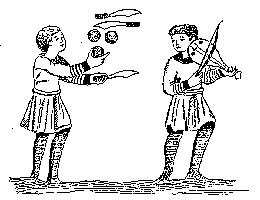 |
| Medieval jugglers, after a well-known old print. |
Some historians believe that the French jongleur began to
appear as early as the sixth century, and that he was a successor
to the trickster and mountebank of the later Roman Domination.
Others believe that the jongleur did not emerge until the eleventh
century, and that he was a combination of the mime and gleeman
who had existed in England. At a time when diversions were few,
these wandering minstrels usually prospered, finding an eager
public at every stop. But despite some gains, their lives were
besprinkled with bad times. Inadequate shelter, hunger and cold
were prevalent.
At the end of the eleventh century, the movement of the
"troubadours" began in Provence (now southeast France). These
troubadours were poets of the wealthy class who were interested in
literary pursuits. In time, these aristocrats felt the need of
assistants; and jongleurs, with their many talents, found
immediate acceptance as helpers to the troubadours.
After their affiliation with the
troubadours, the jongleurs traveled from court to court rendering
selections from their repertoire and polishing their routines at
"schools" or "brotherhoods" of minstrelsy. One such brotherhood
was the Confrerie de St. Julian, first recognized in Paris in 1331.
These organizations of jongleurs, however, had existed much
earlier. A confrerie established in Fecamp in the tenth century is
believed to have been the first.
THE KING OF THE JUGGLERS
In England, at the time of William the Conqueror, the title "The
King of the Jugglers" appeared and continued to appear for over
four centuries. Many privileges went along with the title, which
was conferred by statute. We must remember that the word
juggler in the England of the time was as broad in meaning as
"jongleur" in France. The title, consequently, could have applied
to musician, poet, or any enterprising showman who had gained
the favors of the court.
Throughout the Middle Ages the working juggler remained
emphatically the servitor of the marketplace, the travelling fair,
or the dusty road where he would perform for a few coins or in
exchange for food or clothing. In an early account of what
juggling was in those days:
The trained bear was led away and the jugglers entered. A man
and a boy. They carefully unfolded their bags and began
performing. The man, running around in small circles, rapidly
juggled with three knives. The boy, whip in hand, would at
times, in jest, castigate the man whenever he fumbled. The effect
was dexterous, comical, and most entertaining. After the older
minstrel had walked on his hands and juggled with balls, the pair
collected some coins, folded their bags, and calmly walked away to
disappear into the mob. The singers now entered with their music
scrolls in hand. [2]
THE SEVENTEENTH CENTURY
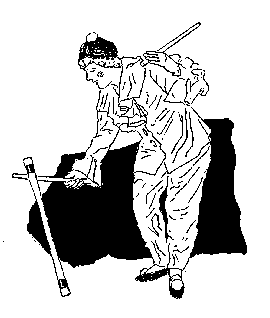 |
| Marion Drew |
At the time of Newton's breakthrough in scientific
research, the English had yet to discover tea and were just
beginning to relish the "strange brew" imported from China.
Itinerant entertainers were common and jugglers traveled from city
to city carrying their equipment in small bags tied to their belts.
Very few names of jugglers from that period exist. German
historian and collector Max Koch, however, does mention some
names from that period, including women jugglers. Unfortunately,
these early artists have marched into oblivion, mainly because
there aren't enough specifics to firmly establish their identity or
even their existence. (See chronology at end of this history.)
Prints of that era, however, give us an insight into the kind of
work then popular. Cannonballs, devil sticks, and ball tossing
were widely used. And when the hurdy-gurdy was later
introduced, it became important in providing musical
accompaniment .
The ancients viewed jugglers with suspicion
and not without reason. The art was often practiced by
vagabonds, rogues, and outlaws. To compound the problem,
jugglers had no way of leaving their accomplishments for
posterity. Whereas other men could leave documents, paintings,
and musical manuscripts, jugglers could do nothing of the sort.
In our modern world of motion pictures and videotapes, this
problem, naturally, does not exist. To illustrate the ignominious
light in which jugglers were viewed, I quote:
Qual mestiers es plus aontos, d'eser joglar o laire? [3]
Which is a more shameful calling, to be a jongleur or a thief?
As villages grew into towns, new forms of entertainment were
organized. The popular Miracle Play, over several centuries, developed into the theater that we know today. The theater, and
entertainment in general, is so fascinating that we are tempted to make an in-depth study of its history. But such a task is beyond
the scope of this book. We can only focus on areas known to have
affected the destiny of juggling.
Footnotes
[1]-
Used by permission. Hermann Sagemüller: Michael Kara, König
der Jongleure - Jongleur der Könige. Selbstverlag Baldingen;
1973, p.7
[2]-
Collected Stories from London, 1907.
[3]-
Robert Briffault: The Troubadours. Indiana University
Press; 1965.
[Index]
[Previous]
[Next]
Juggling - its history and greatest performers /
Juggling Information Service /
jis@juggling.org
Text and illustrations © 1984 Francisco Alvarez
HTML © 1997 Juggling Information Service. All Rights Reserved.